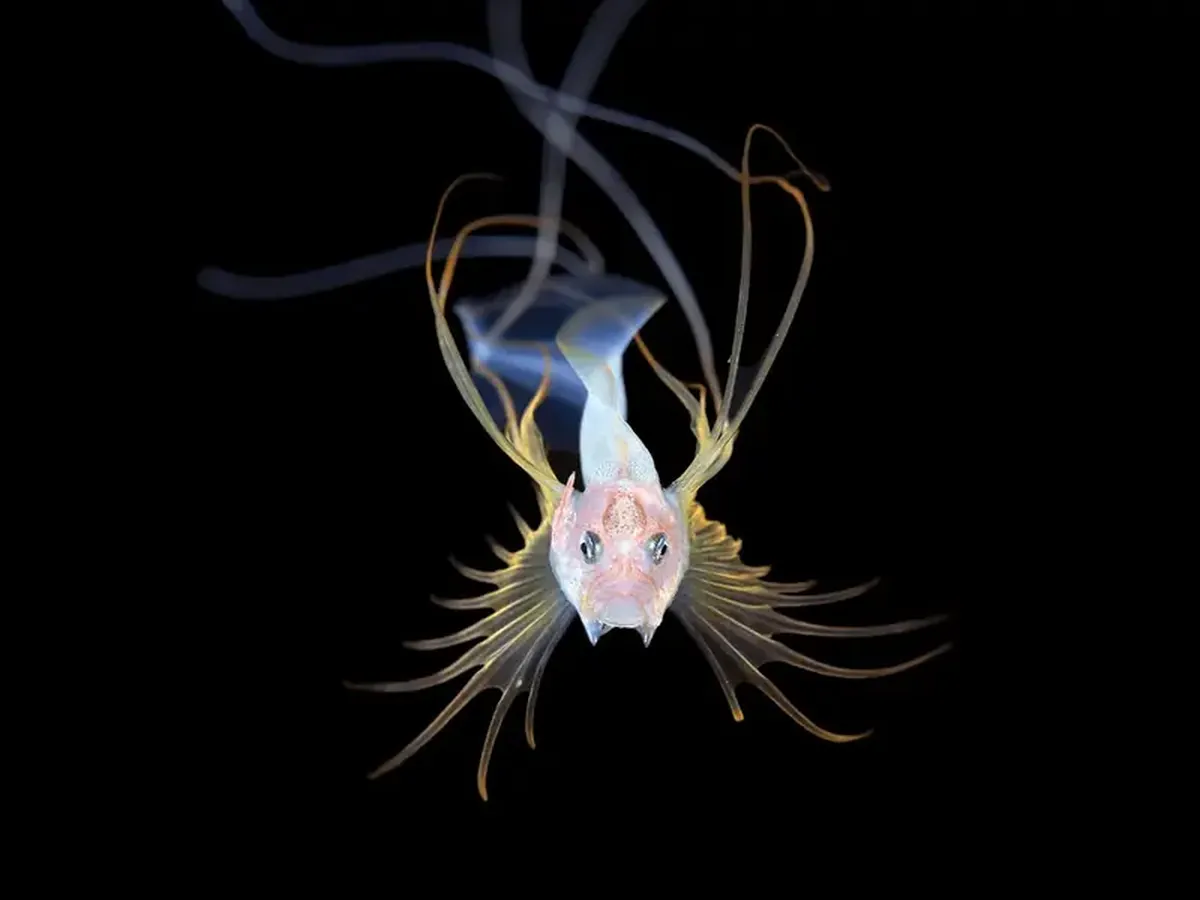What could be more beautiful than tiny sea creatures shimmering in the dark water with every imaginable color? As the sun sets over Florida and the sky and sea turn black, 55-year-old Palm Beach dentist Steven Kovach pulls out his photography gear, meets up with friends, and heads out to the open ocean by boat.

Then Kovach dives into the inky waters of the Atlantic, plunging down to a depth of 15 meters, waiting for the new stars of his underwater stories to appear. Giant hammerhead sharks and swordfish glide past him. For this photographer, communicating with these predators is not entirely comfortable, but it’s undeniably fascinating. However, these giants are not his favorite subjects. Kovach is on the hunt for tiny creatures—mostly rare and deep-sea species. His models are often in their larval stage, and their size typically doesn’t exceed that of a dime.

They migrate through the darkness over considerable distances. To capture them with incredible detail, Steven uses a camera with a macro lens and strobes. He became a certified diver back in high school, but it took him a while to afford such valuable underwater photography equipment. The technique of photographing animals in the deep night ocean is known as “black water photography,” as noted by Smithsonian Magazine.

Kovach expands his chronicle of miniature creatures not only off the coast of Florida but also near the Hawaiian and Cayman Islands, Indonesia, the Philippines, Japan, and Mexico. Interestingly, Kovach’s photographs are notable not just for their beauty and the incredible imagery but also for their scientific value. When the photographer spots a creature he has never seen before, he makes sure to capture it on camera. He then sends the photos to scientists at the Smithsonian Institution in Washington. Occasionally, Steven immerses a larva in alcohol and also sends it to researchers. According to scientists, he does not harm the ocean’s ecosystem in this way, as over 99 percent of larvae of many species do not survive to adulthood. Thus, Kovach has even been issued a license allowing him to keep rare specimens for scientific purposes.

Journalists from Smithsonian Magazine—a publication of the Smithsonian Institution—interviewed Steven Kovach about his amazing passion, which can be considered a second career for him. What challenges does someone working in the field of black water photography face? First and foremost, you’re suspended in the depths and can’t see the bottom. The animals are certainly not happy to see you; they flee, trying to hide. Technically, this is much more complicated than regular macro photography of reefs.

And what is the greatest reward for such a master? Encountering animals he has never seen before. Just a few weeks ago, on the island of Kona, we found a deep-sea anglerfish that had never been photographed before. For me, that was pure bliss. What is your favorite image captured from the black water? Oh, that’s a tough question. I have so many favorites. Among them is the spookfish (Acanthonus Armatus), which is frequently found off the coast of Florida. It’s one of the most beautiful creatures I’ve ever seen underwater. It’s unusual and rare. Adult specimens of this species live at significant depths, so seeing them is a great stroke of luck.

What is the most challenging aspect of this creative endeavor? It’s not so much difficult to take a picture as it is to find the subject. It’s like a treasure hunt. Some of these animals I’ve searched for for years. Sometimes it’s just a game of patience. The biggest challenge is not giving up until they appear. Some of the creatures you see in the photos took me five to eight years to find. It’s also not easy to get the perfect shot. Capturing a lobster larva riding on a jellyfish is a real challenge. Here, the key is not just to photograph it but to do so in a way that makes the composition look beautiful. Lobsters, like jellyfish, are in constant motion. To catch them in the perfect pose requires a lot of time and shots. Other temperamental models are deep-sea anglerfish. Their larvae are only five to eight millimeters long, hanging upside down and constantly moving. Photographing them is quite a task.

Which of your photographs attracts the most public attention? People generally love colorful images. One of the favorites among them is the shot of a lobster riding on a jellyfish.

Have you encountered marine debris or plastic during your photo hunts? When I go to places like the Philippines or Indonesia, I find a lot of trash in the waters there. There’s not much of it in Hawaii. Sometimes I see it off the coast of Florida, but the amount here is still not critical. I have a whole bunch of images on my Instagram featuring animals and trash. There’s a photo of a nautilus riding on packaging debris and a fish hiding in plastic.

You share a lot of your work on social media. What do you think people will take away from these images? Social media posts are a way to showcase my work to the public. And someone might even want to buy them. Overall, I just enjoy sharing what I see that others might not.
